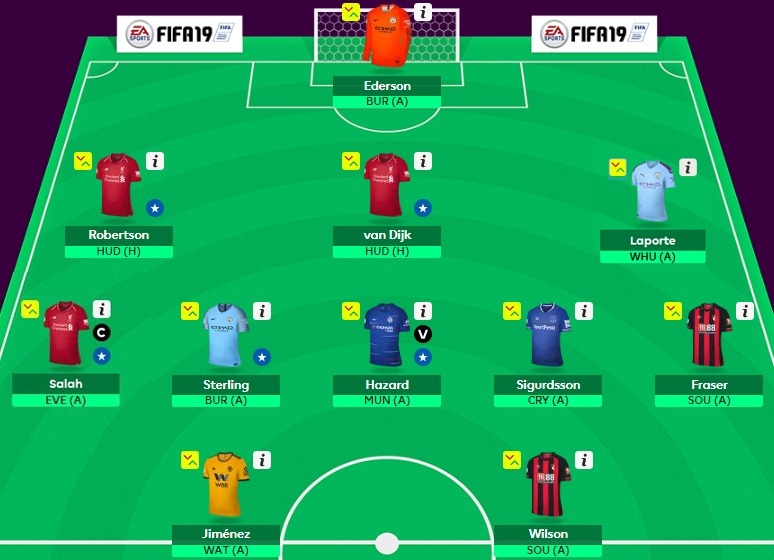A basic idea of FPL is to pick a team that will score the most points through the season. Because of many constraints, we have to deal with, it is not as simply as it sounds. Apart from constraints, there are many risk factors and uncertainties which make our decision-making process difficult as we try to “predict” and evaluate future points for many players.
In this process, historical data about players points are very useful, and such an ex post analysis helps us to understand, which players we should have picked, which formation we should have used and so on. We can learn from this information and avoid similar mistakes in the future. And if we look at historical data, we can use some optimization techniques to solve what team would have scored the most points in some time period. Many people are using metric called points per million when they try to pick the best team, but I am not really fan of this metric because it does not really show how player’s points contribute to the global optima.
I used a genetic algorithm (optimization technique which is able to find global optimum of almost every optimization problem) and found a team that scored the most points in the 2018/19 season. My model respected all FPL constraints and was based on players prices from the beginning of the 18/19 season. It maximized points for a team of 11 players within the budget of 82,5m, which allowed to have bench of players that costed 4m/4,5m/4,5m/4,5m. To make it simple, I did not consider transfers, autosubs, chips, injuries and captain changes, so only one player was a captain for the whole season in this optimal team.
And here is the solution. If you had selected this team at the beginning of the 18/19 season, it would have scored 2469 points without autosubs and only with one captain. It would have been enough to be in top 900 at the end of the season.
Goalkeeper
First, Alisson is not the goalkeeper because there are another 3 Liverpool players, otherwise he would be in the goal. So, we can see that optimal team consists of premium goalkeeper and not some 4,5m one. There is a first difference between selecting GK based on points per million metric and this optimization technique. Many people select a 4,5m goalkeeper because of the higher value (points per million) he offers. In the 18/19 season the highest scoring 4,5m goalkeeper was Etheridge with 154 points and value 34,22 points per million. Ederson’s value was “just” 30,73 points per million but as we can see, Ederson’s 169 points (despite his 5,5m price tag) made better points contribution to optimum than Etheridge’s 154 points. But this really depends on how the rest of the optimal team looks like. A lesson learned from this is that we shouldn’t make our decisions on goalkeepers only on points per million metric and we should always see a bigger picture.
Defenders
It is not a surprise to see that at the back, there are three from top four scoring defenders of the season. There are no 4,5m or 5,0m million defenders because their points did not contribute to the points scored by the optimal team enough.
Midfielders
Big at midfield. In last couple of years, the top scoring player was always a midfielder. It is clear that this is a area that offers a large amount of points and the algorithm recognized it. It shows us that we shouldn’t ignore expensive midfielders and despite their price, they are worthy. There were plenty of discussions about Mo Salah and his price tag throughout the last season. Nevertheless, he is here in the optimal team and with an armband. A captaincy is a huge factor when it comes to selecting the most expensive player in the game.
Forwards
Just Jimenez and Wilson. No Aguero, Aubameyang, Lacazette, Firmino… They were expensive and they just didn’t score enough points to be there. Expensive defenders and midfielders were performing much better than them and it is something to have in mind at the beginning of the new season. After all, Robertson and Van Dijk outscored golden boot winner Aubameyang when it comes to FPL points.
Comparison with points per million value
Now let’s compare the result with a value (points per million) metric. There is a list of 50 most valuable players from the 18/19 season (value is calculated as total points divided by player’s price from the beginning of the season).
| web_name | cost_start | total_points | value |
| Alexander-Arnold | 5 | 185 | 37 |
| Robertson | 6 | 213 | 35,5 |
| van Dijk | 6 | 208 | 34,66667 |
| Etheridge | 4,5 | 154 | 34,22222 |
| Fraser | 5,5 | 181 | 32,90909 |
| Jiménez | 5,5 | 181 | 32,90909 |
| Pickford | 5 | 161 | 32,2 |
| Laporte | 5,5 | 177 | 32,18182 |
| Alisson | 5,5 | 176 | 32 |
| Doherty | 4,5 | 144 | 32 |
| Fabianski | 4,5 | 143 | 31,77778 |
| Digne | 5 | 158 | 31,6 |
| Ederson | 5,5 | 169 | 30,72727 |
| Wan-Bissaka | 4 | 120 | 30 |
| David Luiz | 5,5 | 164 | 29,81818 |
| Pereira | 5 | 146 | 29,2 |
| Foster | 4,5 | 129 | 28,66667 |
| Wilson | 6 | 168 | 28 |
| Boly | 4,5 | 120 | 26,66667 |
| Lloris | 5,5 | 145 | 26,36364 |
| Patrício | 4,5 | 118 | 26,22222 |
| Dubravka | 5 | 131 | 26,2 |
| Kepa | 5,5 | 142 | 25,81818 |
| Keane | 5 | 129 | 25,8 |
| Duffy | 4,5 | 115 | 25,55556 |
| Milivojevic | 6,5 | 166 | 25,53846 |
| van Aanholt | 5,5 | 140 | 25,45455 |
| Redmond | 5,5 | 137 | 24,90909 |
| Alonso | 6,5 | 161 | 24,76923 |
| Westwood | 4,5 | 111 | 24,66667 |
| Rondón | 6 | 148 | 24,66667 |
| Brooks | 5 | 123 | 24,6 |
| Mané | 9,5 | 231 | 24,31579 |
| Azpilicueta | 6,5 | 158 | 24,30769 |
| Sigurdsson | 7,5 | 182 | 24,26667 |
| McArthur | 5 | 121 | 24,2 |
| Deulofeu | 5,5 | 133 | 24,18182 |
| Aké | 5 | 120 | 24 |
| Schmeichel | 5 | 120 | 24 |
| Chilwell | 5 | 118 | 23,6 |
| Camarasa | 4,5 | 106 | 23,55556 |
| Richarlison | 6,5 | 153 | 23,53846 |
| Kanté | 5 | 116 | 23,2 |
| Ryan | 4,5 | 104 | 23,11111 |
| Walker | 6,5 | 150 | 23,07692 |
| Jonny | 4,5 | 103 | 22,88889 |
| Coleman | 5,5 | 125 | 22,72727 |
| Hazard | 10,5 | 238 | 22,66667 |
| Townsend | 6 | 135 | 22,5 |
| Zouma | 5 | 112 | 22,4 |
Players in green got also to the optimal team based on the genetic algorithm. Top value player in the last season was Alexander-Arnold with value 37. He had better value than other three Liverpool players which got to the optimal team and yet, despite his price, his total points scored was not enough to be there instead of one of his teammates. First places of the value table are full of defenders, but the algorithm found that formation that maximized points in last season had just three at the back.
Neither Etheridge’s or Pickford’s value was enough to get there and Ederson was the goalkeeper with the best points contribution to the maximum points scored by the optimal team.
Fraser, Jimenez and Wilson were the most valuable players in their positions and they also got to the optimal team, so in this case the value table had a right insight.
When it comes to midfielders other than Fraser, there were five more valuable midfielders than Sigurdsson: Milivojevič, Redmond, Westwood, Brooks and Mané. Unlike Sigy, neither of them got to the optimal team.
The likes of Camarasa or Kanté offered better value than Hazard, Sterling or Salah. Nevertheless, Salah, Sterling and Hazard made better contribution to the total points scored by the optimal team.
I did not mean to criticize the value – points per million matric. Great on this matric is that it helps us to identify unicorns in the midfield or attack like Fraser and Jimenez. I think we should be careful when we judge other players by their value because it could be misleading and we should always look at the bigger picture and consider player point’s contribution or captaincy factor.
Lessons learned.
- In the 18/19 season, selecting the optimal team from the beginning of the season would not have been enough to win the FPL, but enough to be around top 1k. Transfers and captaincy changes were key in winning it.
- Unlike expensive forwards, expensive defenders and goalkeepers were worth the money.
- Don’t be misled by the value – points per million and always look at the bigger picture and other factors.

![3 Best Captain Picks for FPL GW33 [Captaincy Index] fpl best captain picks](https://www.fantasyfootballreports.com/wp-content/uploads/fpl-best-captain-picks.jpg)


